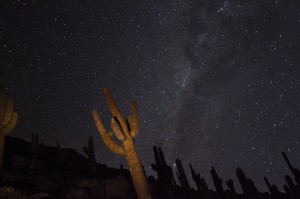We are off by 6 am for the Geysers del Tatio. We are enjoying (HA!) our dry, tasteless sandwiches on the way up the mountain. We arrive before dawn; it is below freezing; and we are at an elevation of 14,173 feet. Thank god Cris brought sweet, hot coffee. There are 80 active geysers here. It is an incredible spectacle to watch thick plumes of steam blow from holes in such a windswept, arid land. Interspersed between the geysers, bubbling pools encrusted with colorful minerals splash and splutter. It’s amazing that visitors are allowed to walk near and around the geysers. Cris says it’s not uncommon for someone to get hurt…and die.
On our way back down the mountain we see incredible wildlife! Cris drives us off-road to his secret place along the river. In fact he won’t stop the car until we get around the corner so the tour groups on the main highway won’t see where we are going. We get a glimpse of a couple of Mountain Viscachas, cute rabbit-like creatures with long tails that are related to chinchillas. We see ducks (Puna Teal Ducks and Crested Ducks) and birds (Andean gulls, Austral Negritos and one White Throated Hawk). But the very best sighting is a male and female Horned Coot on a nest in the middle of the narrow river with chicks! It is so entertaining to see the dad forage for food and come back to the nest filled with all the hungry chicks. The guys take many, many pictures of this sweet scene.
A little further down the road the photographers are finally awarded an incredible flamingo scene. There are 10 or more Andean Flamingos with gorgeous pink feathers. They must be taking their morning baths because they are preening their feathers and stretching their wings.
As we continue Cris is on the lookout for better viewing of the cute Viscachas. They live in rocky areas. We are at the very last rocky area and there they are! Dozens of them drinking at the stream and hopping from rock to rock. We are glad to finally get to see the cute critters up close and posing nicely.
All over the mountainside we see a large, very green, low-growing plant called Llareta. Llareta is unique to the Andes region and is a relative of parsley but it looks like thick moss. Some of the larger plants could be as much as 3,000 years old! In the old days it was dried and used for fuel. You can still see the mountain trails on which runners would transport the plant all over the region for the villages’ fuel needs. Today it is protected.
We have a very nice, local fare lunch at Las Delicias de Carmen in town. We all have cheese empanadas, a small salad and Cazuela (a traditional soup of chicken, corn, pumpkin and potatoes). I have a nice Pisco Sour and the guys have a microbrewery beer made in the southern part of Chile.
We have looked all over town for a working ATM with no luck. We’ve virtually run out of money. But I’m sure the ATMs will be up and running for the weekend.
The little town has an archeological museum so we spend some time there. A good bit of the museum is taken up by displays of hallucinogenic drug paraphernalia from before the Inca Empire. The local people ground up berries from trees and snorted the resulting powder. Apparently it was enjoyed by adults and children alike. When the Incas took control in about 1450, they put a stop to it but got the locals hooked on coco leaves instead.
My knee is the worst that it has been. I really need to rest it. The guys are going back to the same place we went our first night for sunset photos and then back to Quebrada de Guatin for night sky photos. I bow out to rest my knee. The sunset photos are not so great, Howard says, but he enjoys experimenting with photos of the stars and the Milky Way.  The banks of the small river are loaded with Marbled Water Frogs! I wish I could have seen them!
The banks of the small river are loaded with Marbled Water Frogs! I wish I could have seen them!
Howard arrives back “home” about 8:45 and we grab some wine at the hotel bar before we hit the hay.
